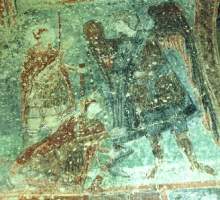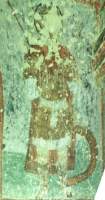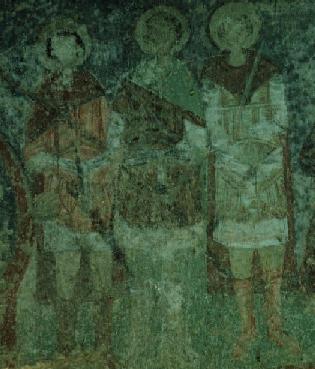
Try Amazon Fresh
Dovecote Church, Cavusin | |||||||||||
|
One of the major themes shown in the murals is the Forty Martyrs of Sebaste. Among these are at least seventeen military figures, not counting those shown in the Crucifixion and the Massacre of the Innocents. It is thought that the two military figures on horseback may represent donors to the Church. | |||||||||||
| A frieze of 12 military figures - 10 on foot and two mounted, runs across the northern wall of the nave, just above head height. | |||||||||||
 |
|||||||||||
| Saint Esukhios | Saint Eunoikos | Saint Eliakos | Unk. Saint | Saint Akakios | The Kapik- larios |
Unk. Saint | Saint Mikalos | Saint Ioanos (John) | Saint Bebianos | Magister Melias (donor) | Unknown Donor (possibly John Tzimiskes) |
In describing the equipment of these warriors, I mostly follow the terminology used by Dawson in "Suntagma Hoplon: The equipment of regular Byzantine troops c. 950 to c. 1204" and "Kremasmata, Kabadion, Klibanion". Any errors or misinterpretations are my own. I will be using the following terms; klibanion - a corselet - armour covering the chest, either of scale or lamellar construction lorikion - a shirt of interlinked iron rings - a hauberk, byrnie or mail-shirt epilorikion - A padded garment covering the torso, worn over the armour kremasmata - a skirt of armour, of any of various construction methods, including padded and quilted fabric toubia, kampotoubia - these terms seem to be able to be used interchangeably to describe leg coverings, either full or half length, padded protection or mere hose. I have been selective and somewhat inaccurate, in choosing to call padded leggings kampotoubia, and those which are basically unpadded stockings, toubia |
|||||||||||
| The figures have several things in common. Each standing warrior wears a cloak, a white tunic under his armour, and a white sash tied around his waist, perhaps as a badge of rank.
This sash occurs frequently in representations of military saints, but is usually higher up on the chest.
However, people who've tried re-constructing this tell me that the sash usually refuses to stay in place and slips down to waist level.
Perhaps these illustrations show more accurately how the sash was worn.
Many of the figures appear to be wearing a garment over the torso armour, whether a padded epilorikion, or just a tunic of some sort.
Some (on Saints Esukios and Eliakos) seem to be decorated with jewels or pearls.
Each of the standing figures has short armoured sleeves coming part-way down the upper arm,
though in the case of the Unknown Saint (figure 7), these seem to extend down the whole upper arm. Each figure bears a sword in his right hand, resting on his right shoulder. Nicolle interprets these swords as single-edged, but I'm not so sure - the evidence is equivocal. The figure on the far right also carries a bamboo spear in his left hand. The mounted figures share very few of these details, and I will deal with them separately. |
| More Warrior Saints on the Walls of the Dovecote Church. |
 Two warriors appear on the eastern wall on either side of the apse. One is a scene of Joshua with the Archangel Michael, the other figure stands alone. |
 Unknown Military Saint |
These three saints stand high on the western wall of the apse, close to the doorway to the narthex. They are armoured in a similar way to the soldiers in the frieze.
 |
||
| Saint 1 | Saint 2 | Saint 3 |
by Steven Lowe
Frieze Saints 6, 7 & 8 are referenced on p.40, Romano-Byzantine Armies 4th-9th Centuries by David Nicolle and Angus McBride
The 'Forty martyrs' on a Cappadocian wall painting of the mid-10th century probably give a much clearer impression of the equipment, costume and horse harness used by Byzantine frontier armies than does finer art from the Imperial capital. Here a variety of arms and armour is shown, including single and double-edged straight swords, a cuirass of probably hardened leather scales (left centre) and perhaps linen-covered felt or leather cuirasses (right & centre right). (In situ, Dovecote Church at Cavusin, AD 963-969, Turkey)
Back to The Depiction of Byzantine Military Equipment in Kappadokian Murals, by Steven Lowe
See also Byzantine Icon of Saint Demetrios, Metropolitan Museum of Art, New York, second half of 10th century
A Byzantine Casket, 10th-11th century, Musée National du Moyen Âge, Paris, France
The Hidden Church (Sakli Kilise) Cappadocia, Turkey, showing Byzantine soldiers, by Steven Lowe
Other Byzantine Illustrations of Costume & Soldiers
10th Century Illustrations of Costume & Soldiers
